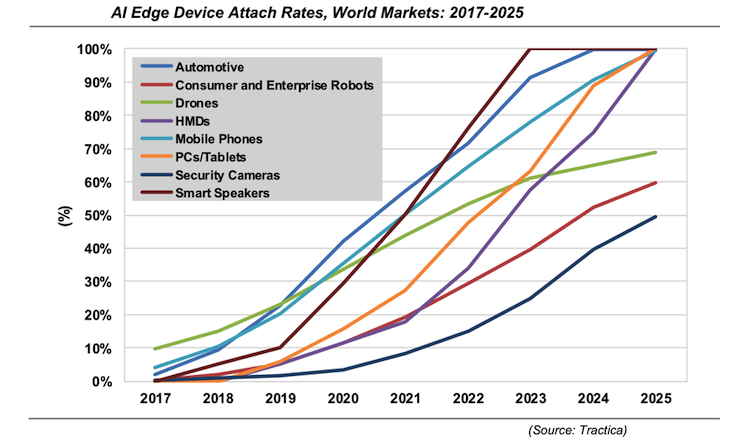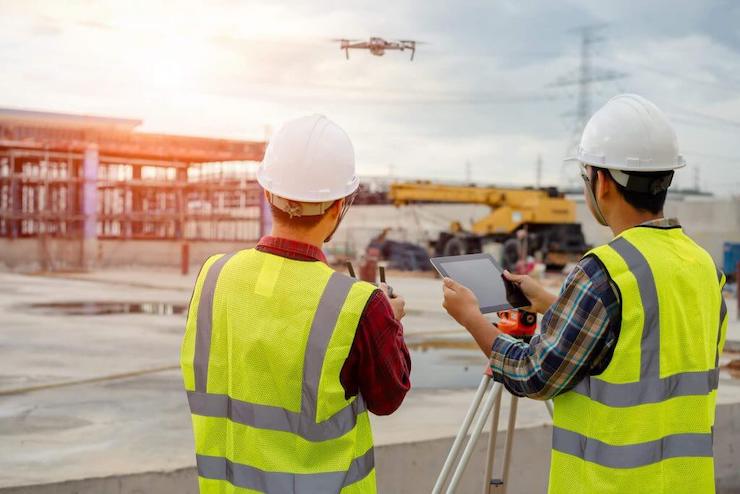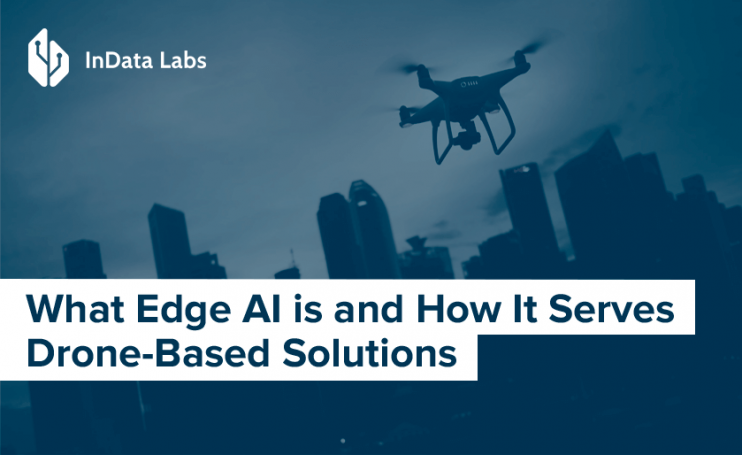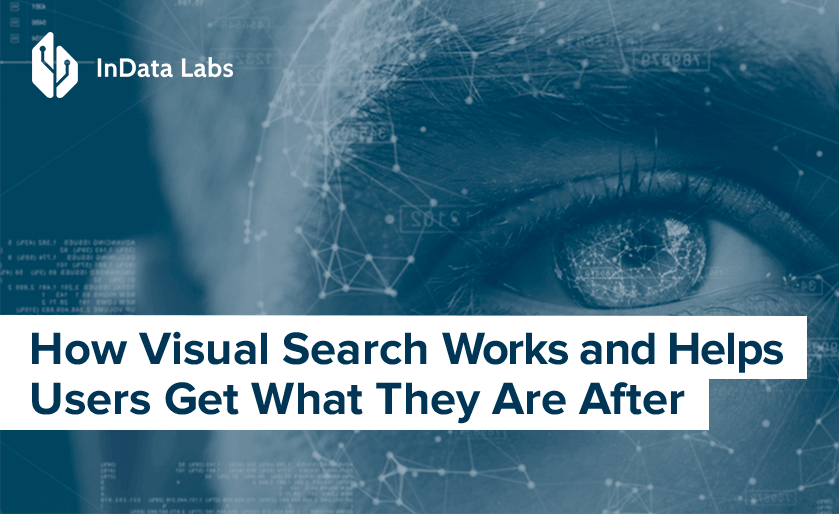The concept of the Internet of Things (IoT) is about as popular as the field of artificial intelligence (AI), machine learning (ML), and big data. According to Statista, the number of IoT devices worldwide is projected to reach 75.44 billion by 2025. Such are sensors, smart speakers, PCs and tablets, cameras, automobiles, robots, drones, and so on.
The functioning of IoT systems is extremely data-driven. At the dawn of connected devices, data collected from multiple sources came into on-premise systems for processing. Then, data-related operations have migrated from on-premise systems to cloud environments. To date, implementing edge computing for IoT is not a luxury but a necessity.
Edge computing has given rise to the concept of edge AI. Complex machine learning models as well are relocating to the edge.
What is edge computing, and what is edge AI? How can your business benefit from it? Why does your organization need to learn how to implement AI at the edge?
Let us talk you through these all.
Edge Computing vs Cloud Computing for AI
Edge computing implies decentralization. It means data doesn’t need to go a long way to the place where it can be stored for further uses. Edge computing eliminates the need to send data to a centralized computing environment, that is, to the cloud. All the processing and analyzing are possible on-site.
So, the main difference between edge computing and cloud computing is that data analysis can be conducted close to the data sources. These sources of data are smart digital devices that transmit data, whether in real-time or delayed mode, into the central data repository or node. Then, data can be handled out of the data center and in a location where data streams are generated.
The volumes of data around the world are growing exponentially and will reach 79.4 zettabytes by the year 2025. It is edge computing that can help handle an immense weight of data. Share on XEdge computing helps overcome such downsides of clouds as the dependence on latency and bandwidth. What is more, the speed of data transmission and timeliness of data analysis are closely tied to hardware capacity that edge computing is independent of. That is why edge computing finds wide application in remote areas and locations difficult to reach.
AI at the Edge
AI moves into smart devices. The agility of data-related processes at the edge makes the edge AI hardware market to grow in size faster. It is predicted to amount to 1559.3 million units by 2024. This fact underpins a host of new capabilities edge AI can offer to businesses.
Edge infrastructure enables data collection and residing in the same location. For instance, drones, consumer and enterprise robots are gaining more and more popularity whilst acting as edge devices that generate data requiring processing.

Edge data processing, independent of hardware restrictions, goes hand-in-hand with more privacy and more data transfer security. That is one of the key reasons to consider locating more complicated AI algorithms at the edge.
Edge AI means that AI algorithms are running locally on hardware devices. The algorithms work based on using data generated on the device. But since neural networks fuel most of AI systems today, running such systems at the edge requires a lot of computing power.
The challenge in meeting the performance requirements for AI inference is in ensuring high accuracy of the output of algorithms within low power consumption. However, the breakthrough in hardware options, including graphics processing units (GPUs), central processing units (CPUs), application-specific integrated circuits (ASICs), and system-on-a-chip (SoC) accelerators, has made edge AI possible. Such hardware market leaders as NVIDIA, Intel, and Qualcomm contribute immensely to the development of AI at the edge.
Another factor is that AI inference requires much less computing resources than ML model training. The amount of data the algorithm needs to provide the output is several times smaller than training datasets.
Thomas Bittman, Gartner analyst, touched upon edge infrastructure superiority over cloud computing in his article The Edge Will Eat the Cloud. He shared that cloud computing may lack the capacity to meet data processing needs. As he pointed it out, trends towards centralization, space savings, self-service, and pervasive automation pose extra difficulties for employing cloud computing since volumes of data are growing faster than hardware capacities. People interact with digital assistants and other edge devices in real-time. They want it here and now: to receive a recommendation in a matter of seconds, get instant help with a self-driving car, or get a push notification as driving past a store they are looking for. Automation and acceleration of such tasks require removing bottlenecks in data processing infrastructure.
There is already a solid background for implementing AI at the edge and employing it for delivering benefits to both users and providers. The applications of edge devices augmented with AI vary across industries.
Edge AI Enhances Drones to be Used in Construction, Traffic Monitoring, and Cartography

Source: Shutterstock
Drones are the type of edge devices that can serve multiple purposes. Their work is based on such technologies as visual search, image recognition, object detection and tracking. If you want to find out more about the working principles of these technologies, learn how visual search works on visiting InData Labs Blog.
AI-enhanced drones mimic human visual search psychology to detect and identify people and objects practically the same way humans do. Human psychology and real-world visual search inspire engineers to create powerful data-driven solutions.
Edge AI allows efficient data analysis and output generation, based on the datasets gathered and transferred to the edge node by drones, and helps with the following objectives:
- Real-time object recognition and tracking. Drones can track vehicles and traffic flow for security and safety reasons.
- Predictive maintenance for aging infrastructure. Bridges, roads, and buildings deteriorate over time and may endanger the lives of millions. Drone-assisted monitoring can help ensure that needed repair works will be done in due course.
- Face recognition. While this opportunity triggers debates over the ethics and legitimacy of using the technology, AI drones with facial recognition can be used for good in many cases.
- Logo detection. Marketing teams can use drones to monitor brand presence or collect data to estimate the real impact of brand logo placement.
Drones can facilitate the provision of mapping and cartography services. Building maps might require appointing a specialist or an expert team to get into an area impossible to explore or dangerous to humans, whereas a drone-based solution fueled by edge AI will enable edge devices to work on their own.
If you plan to build a 3D pollution map, drones can assist in gathering data about air, noise, or radiation. They can facilitate creating a damage detection map by scanning roads, bridges, and constructions and delivering all the data into the local data processing center. After that, a provider of AI and big data solutions as InData Labs can assist you in creating custom maps to visualize different kinds of data.
Pros and Cons of Edge AI
Having all the data gathered in one place raises concerns in terms of security, privacy, costs, and hardware capacity. Something can go wrong and cause unforeseen breakdowns in business processes.
Running ML-based algorithms at the edge entails numerous advantages:
- Privacy for user devices
- Eliminated issue of network latency
- Bandwidth won’t be a problem (especially for AR and VR apps)
- Implementing AI at the edge will help, in general, cut expenses on AI processing
- Technologies allow running complex neural network-based solutions on edge devices
But there are some disadvantages you need to take into account:
- Complex AI systems are still difficult to serve at the edge, which could be a risk for business
- Edge AI is a relatively new tendency, and there is some uncertainty of its usages with certain edge devices
- The growing capacity of networks may make cloud AI no less efficient
Depending on your business nature and goals, you can make an informed decision on the further strategy and technologies your business needs to grow and prosper.
In Sum
Edge computing and later edge AI have opened up opportunities for taking a fresh and efficient approach for processing data and fueling a wealth of data-driven solutions. Whether used individually or along with cloud systems, edge infrastructure is what businesses need to enable smooth work of real-time highly personalized custom solutions and applications. Among the key benefits of running AI inference at the edge are the privacy of user devices, security of data transmission, savings on hardware, and absence of issues with bandwidth and latency.
As a recently raised trend, AI at the edge requires informed decision-making. To opt for edge AI to enhance your business processes, you need business acumen and a forward-looking approach to technology implementation. But having grasped the pros and cons of edge infrastructure, you can level up many edge devices, including robots and drones, with the help of edge AI.
Start Your Breakthrough Project with InData Labs
If you need consulting on edge AI software development and help with making big data solutions an asset for your business, contact us and let us take a deep dive into your challenges to find the best options for you.


